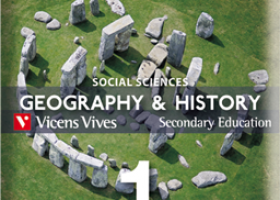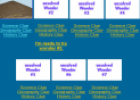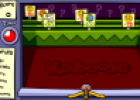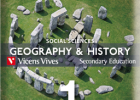Geography and History 1. Social sciences. Geography and history
1. Our planet Earth
2. The representation of the Earth: maps
3. The Earth's relief
4. Rivers and seas
5. Weather and climate
6. Climates and landscapes of the Earth
7. Society and the environment
G. Glossary
8. Prehistory
9. The first civilizations: Mesopotamia and Egypt
10. The Greek world
11. The Roman Empire
12. Spain under the Romans
13. The legacy of classical culture
G. Glossary
Este libro contiene:
-
15 secuencias
-
900 recursos
-
Idioma:
- Inglés
Libro de texto
-
1. Our planet Earth
- Ir a ficha de secuencia
- 0 secuencias
- 60 recursos
The Universe is made up of millions of galaxies. Our galaxy is called the Milky Way. It contains millions of stars, including the Sun. The Earth and seven other planets orbit the Sun. Together they form the Solar System. The Earth spins on its axis. It also orbits (or moves around) the Sun. These movements explain why we have day and night and the changes in the seasons on the Earth.
-
2. The representation of the Earth: maps
- Ir a ficha de secuencia
- 0 secuencias
- 55 recursos
In the past, cartography (or map making) was a very slow process. It involved observation and complex calculations and drawings. Modern maps are made using aerial photos and images from satellites orbiting the Earth. To map a large area, many of these images are put together to produce an exact picture of the planet's surface. Maps help us check our location and find our way around. [...]
-
3. The Earth's relief
- Ir a ficha de secuencia
- 0 secuencias
- 92 recursos
Our planet is made up of land and water. The land is separated into six large landmasses known as continents. The continents are Asia, America, Africa, Antarctica, Europe and Oceania. The continents are not flat. They have different kinds of relief, including plains, plateaus, mountain ranges, valleys and basins. Around the continents are oceans. The action of the water on the land has changed the shape of coastal areas. [...]
-
4. Rivers and seas
- Ir a ficha de secuencia
- 0 secuencias
- 65 recursos
The hydrosphere is made up of all the water on the Earth. This includes the water in the seas, oceans, rivers, lakes, polar ice caps, groundwater and the water vapour in the atmosphere. Water is the most abundant resource on the Earth. It can be found in a solid (ice), liquid (water) or gaseous (vapour) state. Water is the main component in the water cycle, but it is not an unlimited resource.
-
5. Weather and climate
- Ir a ficha de secuencia
- 0 secuencias
- 63 recursos
The weather and the climate are affected by atmospheric phenomena (temperature, humidity, precipitation, atmospheric pressure and wind). These phenomena exist in the Earth's lower atmosphere. Weather and climate are different. The weather describes the atmospheric conditions in a particular place at a particular time. For example, today it is hot in Seville. [...]
-
6. Climates and landscapes of the Earth
- Ir a ficha de secuencia
- 0 secuencias
- 91 recursos
The Earth is divided into three climate zones: the hot zone, the temperate zones and the cold zones. Each zone has a different climate. The variety of climates creates many different types of landscapes. Most of Europe is in the temperate zone. The Iberian Peninsula is located in the south-west of Europe. Its climate has its own unique characteristics.
-
7. Society and the environment
- Ir a ficha de secuencia
- 0 secuencias
- 67 recursos
The human impact on the environment has intensified in recent years. There are lots of reasons for this, such as the growth of consumption and the expansion of cities and industry. Another reason is the application of advanced agricultural techniques as well as the development of transport. There is often a lack of balance in the relationship between the natural world and society. [...]
-
8. Glossary
- Ir a ficha de secuencia
- 0 secuencias
- 7 recursos
Asteroid (n): a small body of rock and metal that orbits the Sun. axis (n): the imaginary line that the Earth spins on. Earth (n): the planet on which we live. equator (n): an imaginary line that encircles the Earth horizontally and divides the planet into two equal hemispheres. hemisphere (n): one of two equal halves of a planet. leap year (n): a year that has 366 days. It occurs once every four years. [...]
-
9. Prehistory
- Ir a ficha de secuencia
- 0 secuencias
- 56 recursos
Prehistory is the period that lasts from the origin of the human species until the appearance of writing (3500 BC). During the Palaeolithic Age, humans were nomads and lived from hunting and gathering. In the Neolithic Age, they became sedentary and learnt to cultivate the land (agriculture) and domesticate animals (raising livestock). In the Metal Ages, metalworking (copper, bronze and iron) was developed. [...]
-
10. The first civilizations: Mesopotamia and Egypt
- Ir a ficha de secuencia
- 0 secuencias
- 65 recursos
Some 6000 years ago in the Middle East, some Neolithic villages became cities as a result of agricultural and commercial prosperity. This led to the first big urban civilisations. These civilisations were the first to invent writing. Much of what we know about the first civilisations comes from written documents from this period.
-
11. The Greek world
- Ir a ficha de secuencia
- 0 secuencias
- 69 recursos
The Greek civilisation developed on the Balkan Peninsula, the islands of the Aegean Sea and in many coastal areas of the Mediterranean. The civilisation was based on the polis. Poleis were independent city-states. However, they were united by a shared language and religion. The first governments were oligarchies (small groups of aristocrats). Later, in Athens, democracy was introduced and the citizens had a say in government. [...]
-
12. The Roman Empire
- Ir a ficha de secuencia
- 0 secuencias
- 81 recursos
Rome was a city on the Italian Peninsula. In the 6th century BC, the people expelled their kings and the city became a republic. In the next centuries, Rome conquered territory all over the Mediterranean and became an empire. The Romans built cities, bridges and roads, and spread their language and culture throughout the Empire. [...]
-
13. Spain under the Romans
- Ir a ficha de secuencia
- 0 secuencias
- 47 recursos
During the 1st millennium BC, Celts and Iberians lived on the Iberian Peninsula. These pre-Roman peoples had received Indo-European, Phoenician and Greek influences. At the end of the 3rf century BC, the Romans began to conquer the Peninsula. They first arrived in Emporion. After two centuries they occupied the entire territory. Roman domination lasted for more than 600 years. During this period, Hispania was just another Roman province. [...]
-
14. The legacy of classical culture
- Ir a ficha de secuencia
- 0 secuencias
- 76 recursos
The culture of the ancient Greeks and Romans is the basis of our western culture. The Greeks were interested in knowledge, art and the organisation of society. Greece was the birthplace of western philosophy, art, the Olympic Games and democracy. The Romans were a more practical people. They influenced our society today through their engineering and urban works, some of their laws and their Latin language.
-
15. Glossary
- Ir a ficha de secuencia
- 0 secuencias
- 6 recursos
Cave art (n): Prehistoric paintings found on the walls and ceilings of caves. hominid (n): a member of the family of mammals that includes humans and their primate ancestors. hunting (n): the activity of catching and killing wild animals for food. livestock (n.): domesticated animals and birds, such as sheep or chickens, kept for food or trade. [...]
Cursos y asignaturas
-
12 años:
- Historia
- Geografía
-
13 años:
- Historia
- Geografía
-
Aún no hay comentarios, ¡comparte tu opinión! Inicia sesión o Únete a Tiching para poder comentar
La licencia digital es una autorización que permite utilizar un recurso digital de acuerdo con las condiciones legales de dicho recurso. El código que recibas una vez la hayas comprado te permitirá acceder al recurso educativo digital elegido.
Puedes consultar más información en nuestra página de ayuda.

























¿Dónde quieres compartirlo?
¿Quieres copiar el enlace?